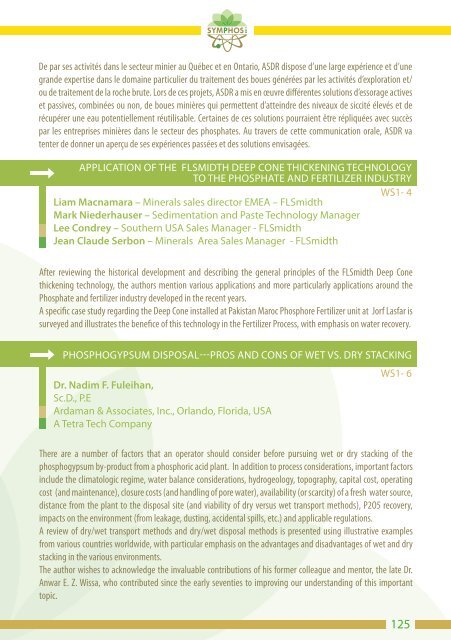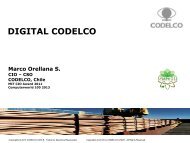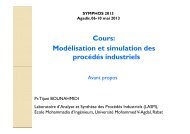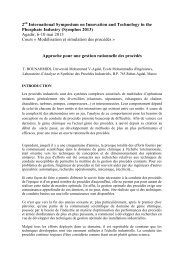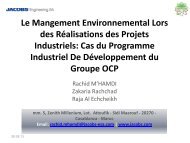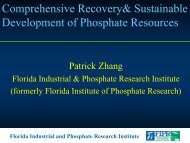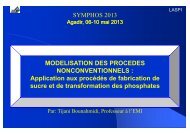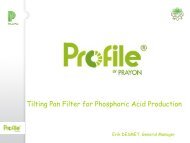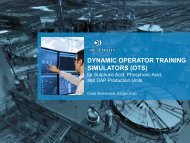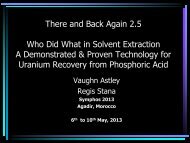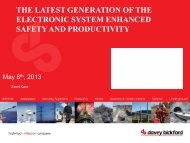Abstract SYMPHOS 2011
Abstract SYMPHOS 2011
Abstract SYMPHOS 2011
You also want an ePaper? Increase the reach of your titles
YUMPU automatically turns print PDFs into web optimized ePapers that Google loves.
De par ses activités dans le secteur minier au Québec et en Ontario, ASDR dispose d’une large expérience et d’une<br />
grande expertise dans le domaine particulier du traitement des boues générées par les activités d’exploration et/<br />
ou de traitement de la roche brute. Lors de ces projets, ASDR a mis en œuvre différentes solutions d’essorage actives<br />
et passives, combinées ou non, de boues minières qui permettent d’atteindre des niveaux de siccité élevés et de<br />
récupérer une eau potentiellement réutilisable. Certaines de ces solutions pourraient être répliquées avec succès<br />
par les entreprises minières dans le secteur des phosphates. Au travers de cette communication orale, ASDR va<br />
tenter de donner un aperçu de ses expériences passées et des solutions envisagées.<br />
APPLICATION OF THE FLSMIDTH DEEP CONE THICKENING TECHNOLOGY<br />
TO THE PHOSPHATE AND FERTILIZER INDUSTRY<br />
Liam Macnamara – Minerals sales director EMEA – FLSmidth<br />
Mark Niederhauser – Sedimentation and Paste Technology Manager<br />
Lee Condrey – Southern USA Sales Manager - FLSmidth<br />
Jean Claude Serbon – Minerals Area Sales Manager - FLSmidth<br />
After reviewing the historical development and describing the general principles of the FLSmidth Deep Cone<br />
thickening technology, the authors mention various applications and more particularly applications around the<br />
Phosphate and fertilizer industry developed in the recent years.<br />
A specific case study regarding the Deep Cone installed at Pakistan Maroc Phosphore Fertilizer unit at Jorf Lasfar is<br />
surveyed and illustrates the benefice of this technology in the Fertilizer Process, with emphasis on water recovery.<br />
Dr. Nadim F. Fuleihan,<br />
Sc.D., P.E<br />
Ardaman & Associates, Inc., Orlando, Florida, USA<br />
A Tetra Tech Company<br />
WS1- 4<br />
PHOSPHOGYPSUM DISPOSAL---PROS AND CONS OF WET VS. DRY STACKING<br />
WS1- 6<br />
There are a number of factors that an operator should consider before pursuing wet or dry stacking of the<br />
phosphogypsum by-product from a phosphoric acid plant. In addition to process considerations, important factors<br />
include the climatologic regime, water balance considerations, hydrogeology, topography, capital cost, operating<br />
cost (and maintenance), closure costs (and handling of pore water), availability (or scarcity) of a fresh water source,<br />
distance from the plant to the disposal site (and viability of dry versus wet transport methods), P2O5 recovery,<br />
impacts on the environment (from leakage, dusting, accidental spills, etc.) and applicable regulations.<br />
A review of dry/wet transport methods and dry/wet disposal methods is presented using illustrative examples<br />
from various countries worldwide, with particular emphasis on the advantages and disadvantages of wet and dry<br />
stacking in the various environments.<br />
The author wishes to acknowledge the invaluable contributions of his former colleague and mentor, the late Dr.<br />
Anwar E. Z. Wissa, who contributed since the early seventies to improving our understanding of this important<br />
topic.<br />
125


